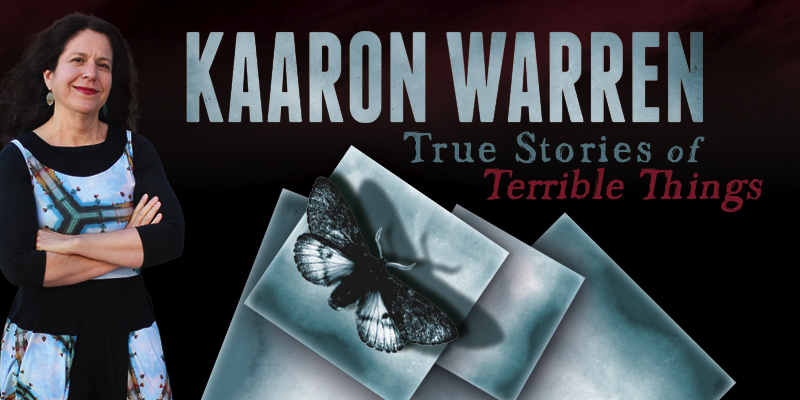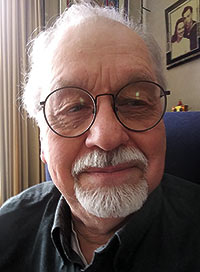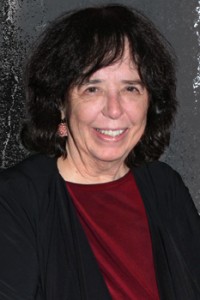Kaaron Warren: True Stories of Terrible Things

Kaaron Warren was born July 3, 1965 in Melbourne Australia.
She began publishing SF with “White Bed” in 1993, and has since published over a hundred stories, including Aurealis Awards winners “A Positive” (1998) and “Air, Water and the Grove” (2013); Ditmar Award winners “Fresh Young Widow” (2005), “The Grinding House” (2005), and “Crisis Apparition” (2018); Stoker Award finalist “All You Can Do Is Breathe” (2011); and World Fantasy Award nominee “Death’s Door Cafe” (2014). Novella “Sky” (2012) won Shirley Jackson, Aurealis, and Ditmar Awards, and was a World Fantasy Award finalist. Some of her stories have been collected in The Grinding House (2005), Dead Sea Fruit (2010), Ditmar Award winner Through Splintered Walls (2012, with Alisa Krasnostein), The Gate Theory (2013), and A Primer to Kaaron Warren (2018).
Ditmar and Australian Shadows Award-winning first novel Slights appeared in 2009, followed by Walking the Tree (2010), Mistification (2011), and Aurealis, Ditmar, and Australian Shadows Award winner The Grief Hole (2016). Her latest novel is Tide of Stone (2018), winner of the Aurealis and a finalist for the Ditmar and Australian Shadows Awards.
Warren has lived in Melbourne and Sydney, and spent three years in Fiji. She now lives in Canberra with her family.
Excerpts from the interview:
“I write dark. I don’t mind being associated with that. I write science fiction as well, but most of my SF leans toward dark imaginings too. My first published story was definitely horror, and once you start being known for that, people have an expectation of what you’re going to write – but it’s also just what I do. The appeal of horror is hard to identify. I think there’s a certain honesty in horror. I started writing, to a certain extent, because I don’t like happy endings. I don’t like the tied-up, unbelievable happy ending that’s just happy because you want to leave the reader with a feeling of being uplifted at the end. Sometimes that’s a sort of dishonesty in a story. Writing horror, I don’t have to do those happy endings. There’s a certain satisfaction in following a story to its honest conclusion. I also think if I’m going to a really dark place, then I’m not being true to the story if I get weak at the end and leave a sense of hope. Not that I don’t ever have a sense of hope at the end.
“For the reader, there’s a certain desire to be made to feel bad. We love true stories of terrible things. We watch the news, and the only thing we want to see is the terrible stuff. Sometimes at the end there’s a happy dog who was born with three legs and is running up a mountain or whatever – to make you feel everything’s okay at the end. But we’re really drawn, as humans, to terrible things happening to other people. There’s an Australian band from the ’70s and ’80s called Skyhooks, and they have a song called ‘Horror Movie’. The song goes, ‘Horror movie, right there on my TV,’ and at the end it turns out to be the 6:30 news – ‘Horror movies, it’s the 6:30 news.’ I was really young when I heard that song for the first time, but I still remember that twist, and the first time I heard it, it was a revelation. That’s the sort of thing I’m looking at: the realities of horror.
“I’m certainly at the literary end of the horror genre, and I can appeal to readers who think they don’t like horror. I did an interesting reading a couple of months ago in Perth in Western Australia. I was there as a resident, which was fantastic. Part of their Writers Centre had a literary dinner, and they were all older people, great supporters of the writing centre, but definitely not genre readers. I read a reasonably dark and nasty story to them. There were ghosts and murder and it was a really sad and dark story. They really liked it. The funny thing was, at the end, one of the women put her hand up and said, ‘Oh, but that’s not horror, is it? I don’t consider that horror.’ I said, ‘Well, it is horror. Just because you like it, and you think it’s a good story, doesn’t mean it’s not horror.’ As you get to a certain level of quality, people try to move you out of horror and into something else. I say, ‘No, it’s horror. I’m sorry, but I’m standing firm on that.’ I write characters that people can relate to, I suppose, which makes it a more accessible kind of horror, maybe.
“I have a story called ‘Sick Cats in Small Spaces’, in A World of Horror. The editor, Eric J. Guignard, wanted a very Australian story, so it’s set in the Australian outback in a pub, and on a car trip through ghost towns of the outback. It took me a little while to figure out what that story was about. It’s a husband and wife and their son who’s 18 or 19, and it’s very much about what happens when your kids get older and start to think about moving out, and what a change that makes for all of us. I’m going through that, too. I’ve got a boy who’s 20 and a girl who’s 18, so we’re getting to the stage where this is happening to us. This horror I created is about me starting to imagine what life will be like – it’s going to be different. My kids are going to be grownups, and they’re going to be their own thing. I realized partway through the story that I had to admit that’s what this story was about, and really go for it.
“I usually try not to make my stories about myself. Often my motivations are things that are concerning me at the time – about what’s happening to communities in Australia. The one I’m working on at the moment is about the ever-growing levels of domestic violence in our cities and suburbs in Australia, and what’s being done and what’s not being done about that. I will turn that concern into a physical, monstrous thing, somehow. I can’t just tell the story of the violence, because that’s in the newspapers every day – that’s the horror movie of the newspapers. I’m trying to figure out how to translate that into a story that has a level of fantasy about it – and is a story, rather than just an account of terrible things. I’m thinking about who the characters will be that can draw the reader in.
“Titles are important. When you name your story, that is the heart of the story. This is obvious, and everyone else knows this already, but it’s just been clarified for me in the last few months, when I’ve been teaching a few writing workshops with kids. They’re doing their work and coming up with stories and characters, and it comes to a moment where I say, ‘Now we’re going to name your story.’ That’s when you start to figure out what’s your story about. Take my novel Tide of Stone as an example: it’s about a very tall tower, and inside are prisoners who’ve been given eternal life, because people think death is too easy for them, and they deserve a fate worse than death. They’re given eternal life, strapped in this tower, and their bodies disintegrate and dry up. It’s a very unpleasant few hundred years for these people. Tide of Stone is about inevitability and about immortality, and the things we’re looking for that we don’t always get, and the harm people do to each other. The Keepers are supposed to be good guys, but they’re awful. Every year there’s another person who comes out and takes care of these prisoners, and terrible things happen and bad choices are deliberately made along the way. The main character is one who comes in at the end, and she discovers choices that people she knows have made, and that changes the way she feels about those people. That happens in real life too, where you find out something about a person that totally changes your perception of them.
“As I said, I try very hard to not put myself in my characters. Philippa, the main character in Tide of Stone, needed to be very different from Stevie, the character in Slights. They’ve got some similarities, so I had to work hard to make Philippa different. I try not to put myself on the page. Certainly some of the motivations to begin the story are my own, but aside from that, I want to make my characters as different from me as possible.”
Interview design by Francesca Myman. Photo by Arley Sorg.
Read the full interview in the June 2019 issue of Locus.
 While you are here, please take a moment to support Locus with a one-time or recurring donation. We rely on reader donations to keep the magazine and site going, and would like to keep the site paywall free, but WE NEED YOUR FINANCIAL SUPPORT to continue quality coverage of the science fiction and fantasy field.
While you are here, please take a moment to support Locus with a one-time or recurring donation. We rely on reader donations to keep the magazine and site going, and would like to keep the site paywall free, but WE NEED YOUR FINANCIAL SUPPORT to continue quality coverage of the science fiction and fantasy field.







